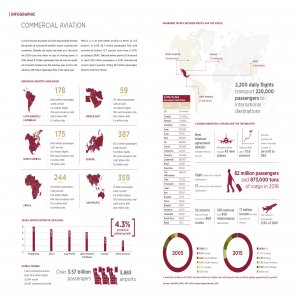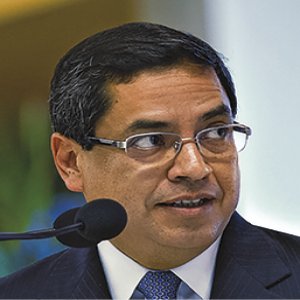Improving Airports, Increasing Flight Safety

STORY INLINE POST
Q: How is the aviation sector growing in Mexico and what global passenger and cargo transport trends are shaping it?
A: The sector is growing at an accelerated pace. In 2016, 82.7 million passengers flew with commercial airlines, which is 46 percent more than in 2012 and reflects an average annual growth rate of 9.8 percent. From January to March 2017, commercial flights grew almost 3 percent in comparison to 2016. During this first quarter of 2017, AICM alone transported 10,364,775 passengers, which represents an increase of almost 10 percent in comparison to the previous year.
Demand for air freight is also increasing. In that same quarter, a total of 184,022 tons of cargo were transported by air, representing a 6.7 percent increase over the same period in 2016. National freight transport rose 9.5 percent in 2017 while international cargo expanded 6 percent. Safety has also improved, by strengthening the effective verification of compliance with the standards established by DGAC.
Global and Mexican flight demand is expected to rise and, if trends continue as expected, by the end of 2017 more than 89 million passengers will travel by airplane.
Q: How has the sector changed and how does DGAC support its development?
A: Low-cost flights have grown exponentially, making it possible for many people to travel by plane and leading airlines to make important changes. Airlines are looking for ways to lower their operating costs as they move to increase efficiency. DGAC verifies that airlines take the necessary measures to ensure that optimal conditions of aircraft and operations safety are met as operational savings are made. Despite cutting operating costs, airlines must guarantee certain services and safety to protect passengers, their belongings and third parties. We have implemented several programs to monitor the activities of concessionaires and air permit-holders with the goal of detecting and preventing unsafe actions in advance.
To permanently improve overall air safety in Mexico and prevent accidents, we have requested aviation service providers to install safety management systems (SMS). Our goal is to organize every air service provider’s checks and systems process to anticipate and address security issues before an accident happens. These systems will also help us resolve problems if an accident does happen.
We tailor the operational parameters of airports and air transport companies so they can qualify for foreign certifications, such as the State Safety Program (SSP), Runway Safety Team (RST), the International Standard for Business Aircraft Operations (IS-BAO), IATA Safety Audit for Ground Operations (ISAGO) and IATA’s Operational Safety Audit (IOSA) for global safety management.
Q: What are the main challenges that the aviation sector will face in Mexico?
A: The biggest challenge is the acquisition of ICAO’s Annex 14 certification. Of the 63 Mexican airports with international flights, 32 comply with this standard; a 51 percent compared to 2015. Mexican airports will continue undergoing this certification process over the next two years. Three of the 16 airports to be certified by the end of 2017 successfully received the certification during the first quarter of the year, so we expect that by the end of 2017, 71 percent of Mexican airports will be certified. The remaining 18 airports should be evaluated with ICAO’s standards by the end of 2018.
Q: What is the aviation industry’s contribution to Mexicans’ quality of life?
A: The industry’s growth has led to the modernization of several airlines’ fleets. Aeroméxico’s introduction of the new generation 787-900 and 737-800, Viva Aerobus, Interjet and Volaris’ acquisitions of the A320-271neo and Aeromar’s integration of the ATR 72-212A y ATR42-500(600) into its fleet all represent modernizations that improve passenger comfort and safety.
Flying is the most effective and safest form of travel so the industry can anticipate the need for more routes to meet rising demand, whether for tourism or business. Growing connectivity is reflected in the increase in passengers. Passenger numbers on domestic flights increased nearly 8 percent in 2016 and the number of international passengers grew over 10 percent.
Aerospace industry growth has boosted connectivity internally and with the rest of the world. The A380 that began operations in January 2016, for example, created direct flights between Mexico City and Paris. New international flight routes include Aeroméxico’s connections with Toronto and Vancouver and Interjet is now traveling to Dallas, Las Vegas, Lima, Chicago, Santa Clara, Orlando, and Chicago. Aeromar also has a new direct flight to Tucson from Mexico and new airlines like Alitalia and All Nippon Airlines (ANA) are linking Mexico with direct flights to Rome, Italy and Narita in Japan, respectively. These air links broaden Mexico’s options for business and pleasure travel.
Q: How instrumental has BASA been for the growth of the aerospace sector?
A: BASA has generated growth in the aeronautical industry, in sectors ranging from design to parts production. It has also facilitated the development of manufacturing hubs such as that located at Queretaro’s airport. Due to the success of this agreement, we are looking for a similar deal with European authorities to certify parts that will be exported to Europe. Mexican manufacturing is growing quickly and increasingly gaining global recognition so we are keen on obtaining quality certifications to export further and faster.
On top of developing Mexico’s production, BASA has boosted civil aviation safety. The DGAC is working with the Ministry of Foreign Affairs and the Ministry of the Interior on transport safety management to develop personnel. The goal is to improve specific regulations for civil aviation via measures including consultations, training and equipment donation for aviation security.
Q: What strategies exist to prevent flight delays and simplify processes in Mexico City’s airport?
A: The AICM is re-engineering its operations to consolidate flights, allocate slots to airlines fairly and to meet percentages stipulated by the Federal Antitrust Commission (COFECE). It is also working toward the efficient use of slots, stipulating that airlines must apply best practices. Alongside COFECE, we have implemented programs for efficient slot allocation and to monitor compliance with IATA standards. In accordance with new amendments to the Civil Aviation Act on passenger rights, new policies have also been created to monitor compliance with the new rules protecting passengers’ rights. We will see the application of these rights in all airlines to improve passengers’ experience.
Q: How is airport construction changing to make them more sustainable?
A: NAICM, which will replace the existing airport in Mexico City, will be the first sustainable airport in the country. Its construction should address flight demand to and from Mexico and create new jobs in the aviation sector, all while meeting environmental standards. Mexico’s 2015-2018 Plan to Mitigate Greenhouse Gas Emissions in Mexican Civil Aviation (Plan de Acción de México para Reducir las Emisiones de Gases de Efecto Invernadero de la Aviación Civil Mexicana) includes strategies for infrastructure improvements in airports, building on the 97 percent of all airports that have procedures for handling, storage and final disposal of solid waste. More than 65 percent of airports that are concessions of airport groups keep inventories of direct and indirect hazardous waste management but this can be increased. The plan also encompasses objectives to improve airport facilities and services that would contribute specifically to the reduction of air pollution.























